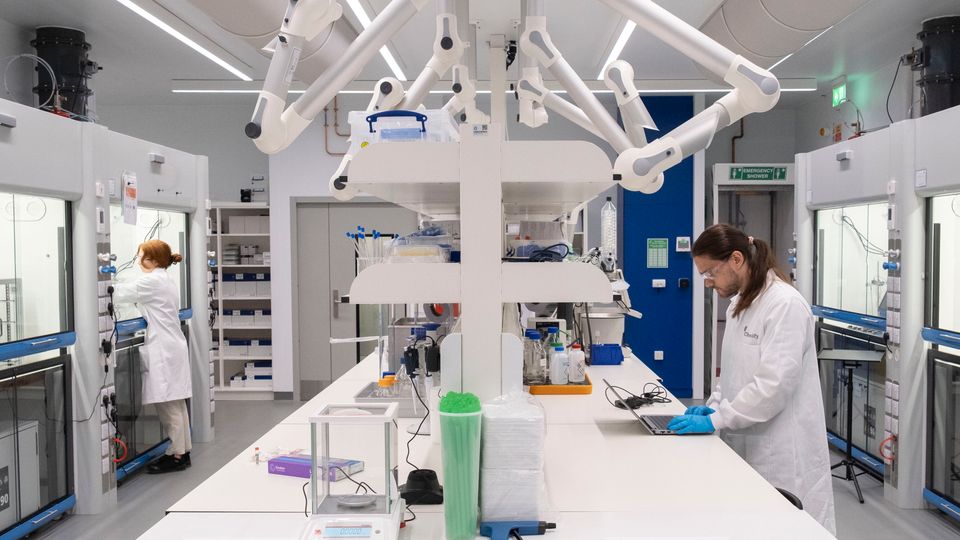“Chemputation” and the Rise of Digital Chemistry
Explore how digital chemistry, “chemputation” and automation are transforming drug and materials discovery.

Digital chemistry is a rapidly evolving field that combines traditional chemistry with breakthroughs in automation, data science, computing and digital technologies. In essence, chemists make use of digital toolkits and algorithms to simulate, predict and accelerate chemical processes, to address key societal needs and global challenges.
Leroy “Lee” Cronin FRSE FRSC is the Regius Professor of Chemistry at the University of Glasgow and is a pioneer in the field of digital chemistry. His academic research focuses on three main themes: chemical synthesis and self-assembly, molecular devices and complex chemical systems. In 2022, Cronin’s work resulted in the founding of a new digital chemistry spin-out company, Chemify.
Chemify recently unveiled its first “Chemifarm”, a 21,500-ft² fully-automated chemistry facility in the north of Glasgow that combines Chemify’s artificial intelligence (AI)-driven molecular-design engine with industrial-scale robotics, seeking to accelerate the discovery of new small-molecule drugs and next-generation materials.
At the heart of the Chemifarm is Cronin’s “Chemputation” platform, which makes use of a bespoke chemical programming language, laboratory robotics and a vast digital library of chemical reactions that can be used to support the design, synthesis, optimization and scale-up of new molecules.
To learn more about the field of digital chemistry, the opening of the Chemifarm and the future of chemputation, Technology Networks spoke with Cronin at his office in Glasgow.
What is meant by the terms “chemputation” and “chemical programming language”?
The process of chemputation comes from the understanding that there is a way to take the diverse aspects of chemistry and make them more deterministic in some regard. My question was essentially, is there some way I can program chemistry?
What do I mean by programming chemistry? Well, if you program a computer, you write some code, you give it some input and the input gets transformed by the program into an output. If you gave the program the next day the same input, you would get the same output. It’s a very mechanical, algorithmic process. Now, all of this thought is happening years before the rise in machine learning or AI, so the idea of some kind of algorithm for chemistry was a bit confusing to people. But I said, let's make a programming language for chemistry.
For that, we need hardware, we need a machine code, we need all the kinds of architecture that you have on the computer to also be possible for chemistry. So I worked backwards, starting from what the chemist would need on the bench, working out what is the minimum viable “chemistry set” that I could program to make chemistry more reproducible. That is where the idea of chemputation came from.
The algebra in chemistry is very simple; the only four things you need to do in chemistry are: add matter, subtract matter, add energy, subtract energy. I wrote a chemical programming language based around those four things, which we call “primitives”. This programming language is a bridge between the human chemist who thinks in terms of adding stuff and subtracting stuff, and the robot that thinks in code and 1’s and 0’s. The robot needs to somehow understand what the chemist wants and what chemistry needs to be actioned, and the chemical programming language is what connects the chemist to the robot without any danger.
Chemify has recently opened its first Chemifarm facility in Glasgow. Can you tell us more about this facility?
The Chemifarm brings together a whole range of different innovations. Firstly, it's the first commercial implementation of a chemical programming language in history, which is very exciting. That allows people to run the robotics without needing a PhD in chemistry, so it makes it more accessible, more reliable and safer.
For the people who are working there, it means that they are not just mindlessly pouring liquids every day – they can spend their time thinking about designing better drugs or materials or things like that.
The central advancement is that the Chemifarm is a convergence of the cutting-edge robotics that we have built internally, the programming language that we built internally and the knowledge of the correct chemistry that we can do to make the molecules we need. This trifecta is the hardware, software and “wetware”, as I call it.
The other aspect is, the Chemifarm is very modular and scalable. Once we’ve proven the unit economics with this one Chemifarm, we can start to put them anywhere. I am going to put one on the moon, I kid you not.
Think about it, if we are going to populate the moon or somewhere in space, then we’ll have astronauts there. They are going to need a Chemifarm or a miniature set of chemputation machines to do chemistry on demand. Maybe it’s to make epoxy, maybe it’s to make medicines, but you can work out what the minimum kind of survival kit that you would need is, and then you have chemical manufacturing on the moon.
Pursuing new strategies for expanding
drug design and materials discovery is a huge topic at the moment. What are the
differences between what you are doing at Chemify and other computational
approaches to discovery?
Today, there has been a huge amount of investment in drug discovery and materials design. But what is drug discovery and materials design? I think if you told most people that you’d discovered a new drug that could potentially cure some disease, they would naturally ask, “well, where is it?” And if I replied, “It’s on the computer,” they would tell me that what I have is just a drawing.
The problem with a lot of AI-powered discovery is that they are simulating things on the computer, so the solutions exist in this digital metaverse-type of space. You can discover something using AI, but then when you try to make it by hand, you might discover that you can’t make exactly that type of structure by hand because humans only have a limited amount of time or resources; it’s impractical.
The Chemifarm makes the meta, physical. It essentially ensures that we can turn those designs into real things and do it robotically. Chemify, plus our programming language XDL, allows you to design and discover molecules for real. We design the molecules that come out, we test them to check their performance, and if they need optimization, then we can go back and re-enter that loop. Chemify’s Chemifarm is the first place where true AI materials and drug discovery is being done closed-loop.
I want to ask you about the human element of Chemify. With a lab that features so much robotics and AI, what is the role of the chemist?
This is a good point to stress. All that Chemify is doing is automating the boring and mainstream bits. At Chemify we have around 140 people in the company, despite being only 3.5 years old, and we have people here who unify all aspects of chemistry, engineering, operations, AI, software, etc. Having this nexus of people really allows you to generate new capabilities that haven’t existed before.
The narrative that these things are replacing people’s jobs has always been there, but I do question the motives. We know that AI is not as creative as humans are. I know there’s a lot of hype out there, but AI simply cannot do what humans do. I mean, if I asked ChatGPT to write an article, then it would do it, but being creative and structuring an argument and telling a story? ChatGPT isn’t going to do that – it will always be a facsimile.
I think the misunderstanding is that robotics and algorithms are coming to replace people. I think what they will actually do is just enhance the creativity of people, because who wants to be forced to do boring stuff?
I also think it can give people the opportunity to come into high-value job environments without necessarily having a PhD. One of the visions I have – we’re based in Glasgow, we intend to stay based in Glasgow as we go worldwide – is that it would be great to be able to recruit people from local schools and get them trained to be the drug-hunters or the superconductor-discoverers of the future. Much like how Rolls-Royce hire people from apprenticeships in Derbyshire to start making jet engines; half the people who have ever been on a plane have probably been flown around the world by jet engines made by technicians from Derbyshire.
How do you see the Chemifarm and Chemify’s mission progressing over the next few years?
An interesting thought is, how many unique molecules does the planet and the human race need? If one Chemifarm can discover several thousand new critical molecules every year, how many Chemifarms will we need to produce those? The idea is to use Chemifarms for discovery, but they can also be used for decentralized manufacturing. If you think about the drug shortages that have been happening, these Chemifarms and their decentralized manufacturing could help solve critical supply chain issues.
In the next two years, we will be making sure that the Chemifarm is self-sustaining financially and that we have validated and replicated this Chemifarm model. After that, it’s just a case of continuing to expand and build up the infrastructure for chemistry.



